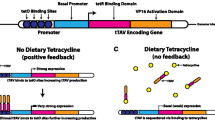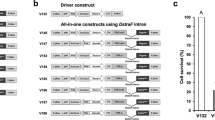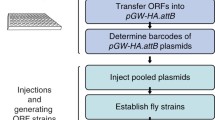Abstract
Since the first report of the release of insects carrying a dominant lethal (RIDL) strategy, RIDL strains have been constructed in species including fruit flies and mosquitoes. However, in many insects, identification of sterile and lethal genes needed to generate a RIDL strain is limited by the lack of molecular and genetic information. Here, we created RIDL strains of Drosophila melanogaster using RNA interference (RNAi) of the Pygopus (Pygo) gene, a key component of the Wingless/Wnt signaling pathway. In two transgenic lines, XD11 and XD15, we verified lethality in the absence of tetracycline, but we were unable to demonstrate sex-specific lethality. We found that male XD15 adults maintained on medium without tetracycline had a longer lifespan than wild type. This RNAi-based RIDL strain may therefore offer the advantages of a transgene that promotes the expression of two contrary actions at different life stages: lethality in larvae and prolonged lifespan in adults, actions that could work together to provide prolonged delivery of lethality by the RIDL system. Use of RNAi can facilitate the development and application of RIDL strategies in a wide range of species.





Similar content being viewed by others
References
Horn C, Wimmer EA (2003) A transgene-based, embryo-specific lethality system for insect pest management. Nat Biotechnol 21:64–70
Thomas DD, Donnelly CA, Wood RJ et al (2000) Insect population control using a dominant, repressible, lethal genetic system. Science 287:2474–2476
Alphey L, Nimmo D, O’Connell S et al (2008) Insect population suppression using engineered insects. Adv Exp Med Biol 627:93–103
Alphey N, Coleman PG, Donnelly CA et al (2007) Managing insecticide resistance by mass release of engineered insects. J Econ Entomol 100:1642–1649
Alphe N, Bonsall MB, Alphey L (2009) Combining pest control and resistance management: synergy of engineered insects with Bt crops. J Econ Entomol 102:717–732
Gong P, Epton MJ, Fu G et al (2005) A dominant lethal genetic system for autocidal control of the Mediterranean fruitfly. Nat Biotechnol 23:453–456
Bargielowski I, Alphey L, Koella JC (2011) Cost of mating and insemination capacity of a genetically modified mosquito aedes aegypti OX513A compared to its wild type counterpart. PLoS One 6:e26086
Tabashnik BE, Sisterson MS, Ellsworth PC et al (2010) Suppressing resistance to Bt cotton with sterile insect releases. Nat Biotechnol 28:1304–1307
Phuc HK, Andreasen MH, Burton RS et al (2007) Late-acting dominant lethal genetic systems and mosquito control. BMC Biol 5:11
Fu G, Condon KC, Epton MJ et al (2007) Female-specific insect lethality engineered using alternative splicing. Nat Biotechnol 25:353–357
Fu G, Lees RS, Nimmo D et al (2010) Female-specific flightless phenotype for mosquito control. Proc Natl Acad Sci USA 107:4550–4554
Lycett GJ, Kafatos FC, Loukeris TG (2004) Conditional expression in the malaria mosquito Anopheles stephensi with Tet-On and Tet-Off systems. Genetics 167:1781–1790
Kennerdell JR, Carthew RW (2000) Heritable gene silencing in Drosophila using double-stranded RNA. Nat Biotechnol 18:896–898
Thompson B, Townsley F, Rosin-Arbesfeld R et al (2002) A new nuclear component of the Wnt signalling pathway. Nat Cell Biol 4:367–373
Parker DS, Jemison J, Cadigan KM (2002) Pygopus, a nuclear PHD-finger protein required for Wingless signaling in Drosophila. Development 129:2565–2576
Belenkaya TY, Han C, Standley HJ et al (2002) Pygopus Encodes a nuclear protein essential for wingless/Wnt signaling. Development 129:4089–4101
Kramps T, Peter O, Brunner E et al (2002) Wnt/wingless signaling requires BCL9/legless-mediated recruitment of pygopus to the nuclear beta-catenin-TCF complex. Cell 109:47–60
Heinrich JC, Scott MJ (2000) A repressible female-specific lethal genetic system for making transgenic insect strains suitable for a sterile-release program. Proc Natl Acad Sci USA 97:8229–8232
Dietzl G, Chen D, Schnorrer F et al (2007) A genome-wide transgenic RNAi library for conditional gene inactivation in Drosophila. Nature 448:151–156
Shelly TE, McInnis DO, Rodd C et al (2007) Sterile insect technique and Mediterranean fruit fly (Diptera: Tephritidae): assessing the utility of aromatherapy in a Hawaiian coffee field. J Econ Entomol 100:273–282
Garabedian MJ, Shepherd BM, Wensink PC (1986) A tissue-specific transcription enhancer from the Drosophila yolk protein 1 gene. Cell 45:859–867
Premsrirut PK, Dow LE, Kim SY et al (2011) A rapid and scalable system for studying gene function in mice using conditional RNA interference. Cell 145:145–158
Jessen S, Gu B, Dai X (2008) Pygopus and the Wnt signaling pathway: a diverse set of connections. Bioessays 30:448–456
Biteau B, Karpac J, Supoyo S et al (2010) Lifespan extension by preserving proliferative homeostasis in Drosophila. PLoS Genet 6:e1001159
Ye X, Zerlanko B, Kennedy A (2007) Downregulation of Wnt signaling is a trigger for formation of facultative heterochromatin and onset of cell senescence in primary human cells. Mol Cell 27:183–196
Franz AW, Sanchez-Vargas I, Piper J et al (2009) Stability and loss of a virus resistance phenotype over time in transgenic mosquitoes harbouring an antiviral effector gene. Insect Mol Biol 18:661–672
Acknowledgements
This work was supported by the National Natural Science Foundation of China (30800721) to Xinda Lin. The authors are very grateful to Dr Maxwell Scott (Institute of Molecular BioSciences, Massey University, New Zealand) for providing the yp1-tTA and tetO-hid constructs. We also thank Miss Lieying Xu (College of Life Sciences, China Jiliang University) for performing genetics experiments.
Conflict of interest
The authors declare that they have no conflict of interest.
Author information
Authors and Affiliations
Corresponding author
About this article
Cite this article
Lin, X., Wang, G. Development of a RNAi-based release of insects carrying a dominant lethal (RIDL) system in Drosophila melanogaster . Sci. Bull. 60, 356–362 (2015). https://doi.org/10.1007/s11434-014-0667-x
Received:
Accepted:
Published:
Issue Date:
DOI: https://doi.org/10.1007/s11434-014-0667-x




